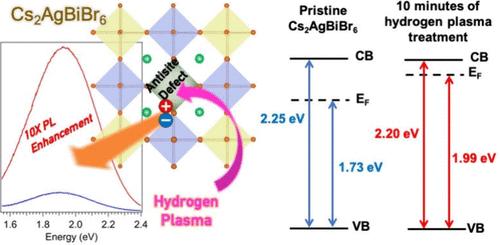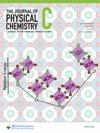Hydrogen Plasma Treatment Compensates for the Intrinsic Defects in Cs2AgBiBr6 Thin Films
IF 3.3
3区 化学
Q2 CHEMISTRY, PHYSICAL
引用次数: 0
Abstract
The prospects of lead-free halide double perovskites in optoelectronic applications are often limited by their indirect bandgap, polaronic carrier transport, and intrinsic electronic defect levels. This work demonstrates a nearly 10-fold enhancement in self-trapped exciton emission intensity for Cs2AgBiBr6 thin films at room temperature following mild hydrogen plasma treatment. Analyzing the emission line widths at varying temperatures indicates that carrier–phonon coupling remains similarly prevalent. However, time-resolved photoluminescence and transient absorption measurements show that defect-mediated recombination is greatly suppressed in hydrogenated Cs2AgBiBr6 films. Based on photoelectron spectroscopy results, we propose that hydrogens can effectively compensate for deep-level Ag-on-Bi antisite defects, consequently shifting the Fermi level toward the conduction band edge. Below the cubic-to-tetragonal structural phase transition temperature, however, hydrogens act instead as nonradiative recombination centers. Taken together, this study highlights the potential of combining hydrogen plasma treatment with B-site disorder engineering to improve the functional characteristics of lead-free halide double perovskites.

等离子氢处理可弥补 Cs2AgBiBr6 薄膜的内在缺陷
无铅卤化物双包晶石在光电应用中的前景往往受到其间接带隙、极性载流子传输和内在电子缺陷水平的限制。这项研究表明,在室温下,经过温和的氢等离子处理后,Cs2AgBiBr6 薄膜的自俘获激子发射强度提高了近 10 倍。对不同温度下发射线宽的分析表明,载流子-声子耦合仍然同样普遍。然而,时间分辨光致发光和瞬态吸收测量表明,在氢化 Cs2AgBiBr6 薄膜中,缺陷介导的重组被大大抑制。根据光电子能谱分析结果,我们认为氢元素可以有效地补偿深层的锑镓反斜长石缺陷,从而使费米级向导带边缘移动。然而,在立方到四方结构相变温度以下,氢反而成为非辐射重组中心。综上所述,本研究强调了将氢等离子处理与 B 位无序工程相结合以改善无铅卤化物双包晶功能特性的潜力。
本文章由计算机程序翻译,如有差异,请以英文原文为准。
求助全文
约1分钟内获得全文
求助全文
来源期刊

The Journal of Physical Chemistry C
化学-材料科学:综合
CiteScore
6.50
自引率
8.10%
发文量
2047
审稿时长
1.8 months
期刊介绍:
The Journal of Physical Chemistry A/B/C is devoted to reporting new and original experimental and theoretical basic research of interest to physical chemists, biophysical chemists, and chemical physicists.
 求助内容:
求助内容: 应助结果提醒方式:
应助结果提醒方式:


